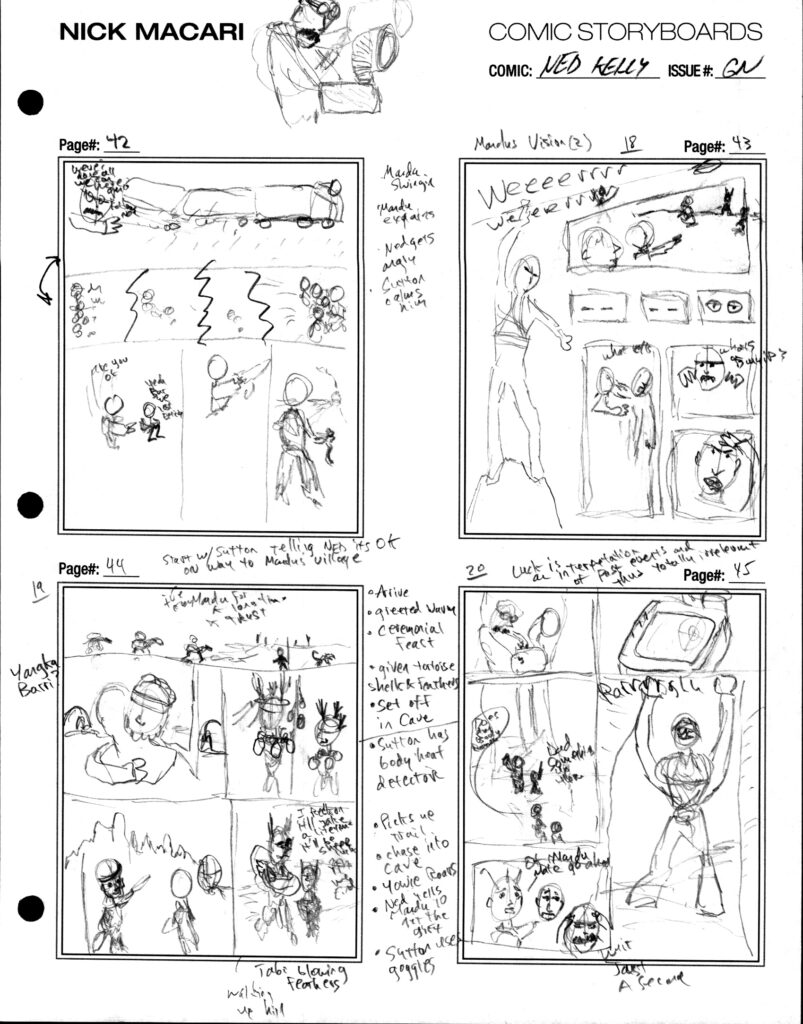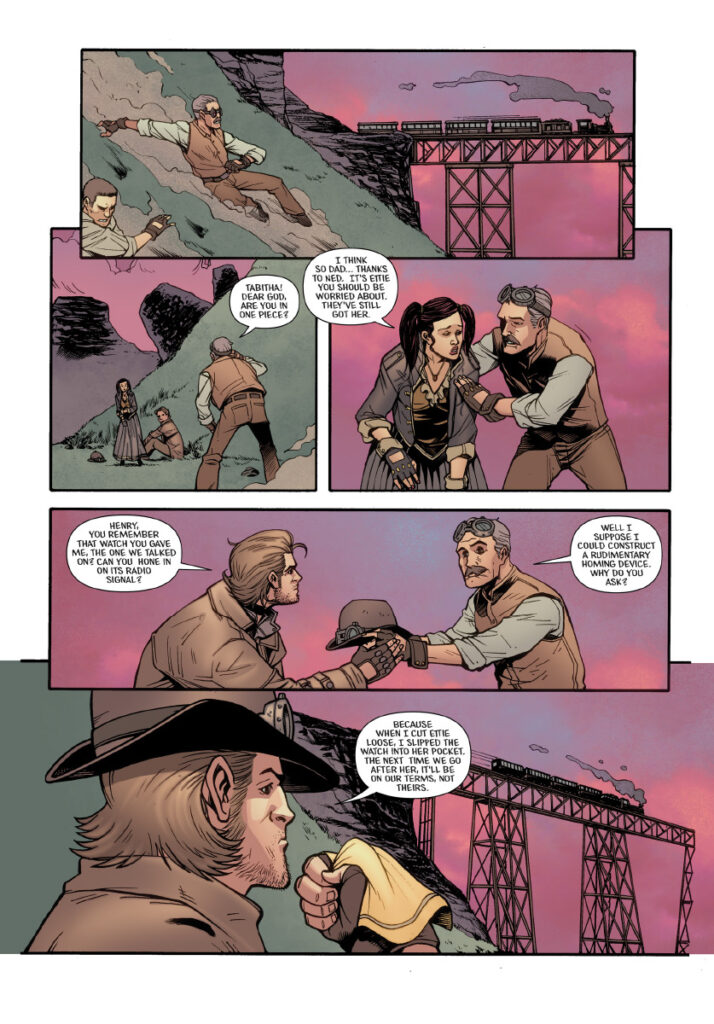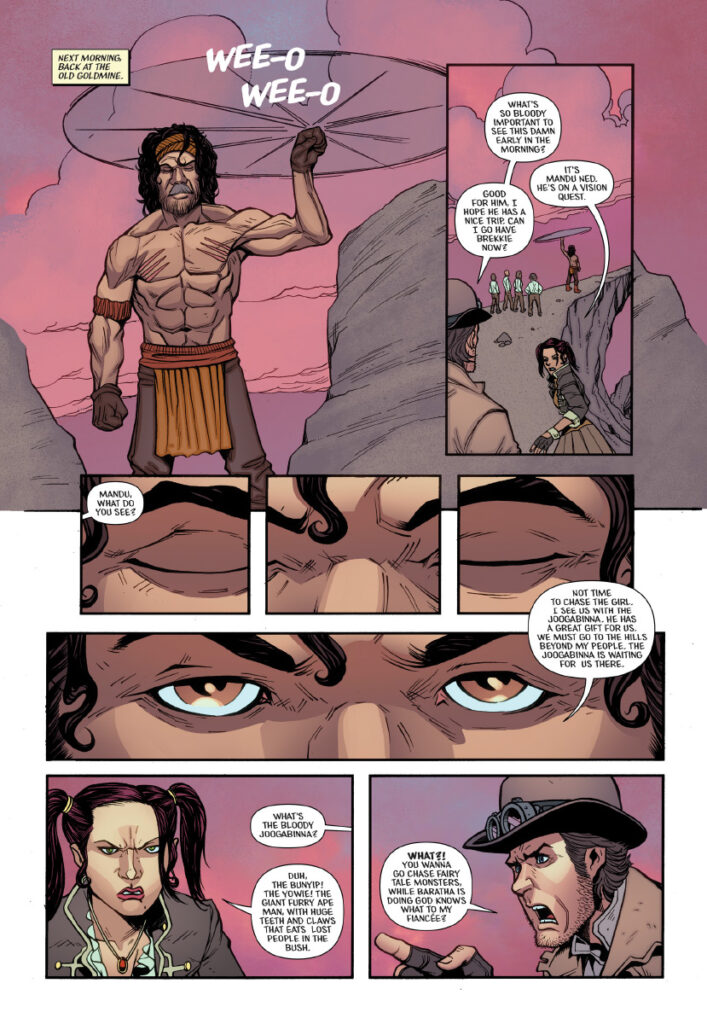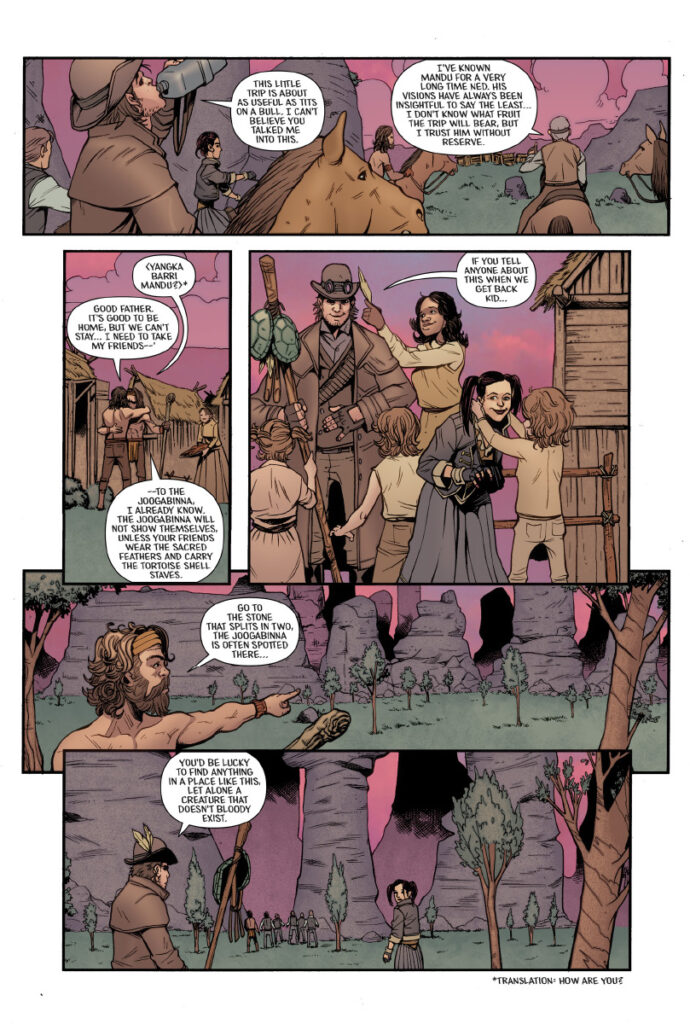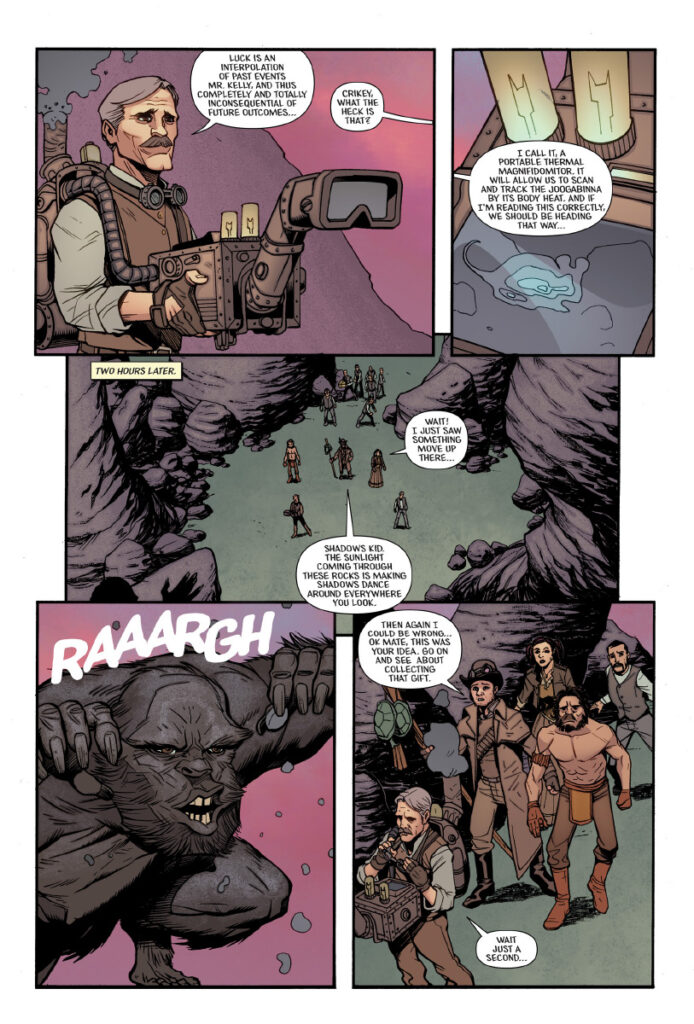When I first started in comics I storyboarded every single page.
In fact, I couldn’t even imagine NOT storyboarding my comic book scripts. At the time, I would have been totally lost trying to write a script without knowing the exact visualizations I was passing to the artist.
This should have been my first red flag that I was doing something wrong.
These days I pretty much never storyboard a script. The only time I do it, is if I’m stuck, having a problem with something, doing some really tricky/complex visualization, but mostly, storyboarding comes into play when I’m fixing someone else’s script and I can’t visualize in my head what the current script is calling for.
Ok, so if storyboarding helps with visualization, why should you not do it?
It may seem counterintuitive at first, but the reason is simple, storyboarding pulls you AWAY from the story itself and into the visualization of the story.
While these two things are not exclusive of each other, the fundamentals of the story itself are far more important than the visualizations. (This is why I wrote the article explaining newer comic writers should forget about camera direction all together!).
Let’s take a look.
The following storyboard come from the Ned Kelly Ironclad Alien Killer graphic novel, errr, actually it was written as a graphic novel but the publisher cracked into a mini-series (which, very sadly, they never completed). Anywhos…
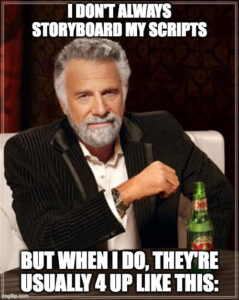
(Though I also have a 2 page format as well.)
I think if you click this image, it’ll get even bigger if you want to see the details or lack thereof. <The page #s of the storyboard are not in sync with the final pages–a page must have been added somewhere before publication. This series of four is one page behind. Sorry for the confusion.>
Before we continue, I’d like to point out, that even when I did storyboard my scripts early on… I very rarely actually delivered the storyboards to the artists… I mean seriously, would you want to try and decipher 100 pages of this chicken scratch crap?
No, the storyboards were primarily for me. So, “I” could visualize the story and adequately pass my DESCRIPTIONS to the artists.
Ok, where was I.
Right.
So there are the storyboards I threw together. Now let’s see the final pages.
For sake of time and space, I’m going to focus on one page, 44.
I highlighted portions of the script that focus directly on camera direction and visualization.
Here’s the script.
*** PAGE 44 (8 PANEL) scene 18
Panel 1: EXT. AUSTRALIAN BUSH HIGH PLATEAU – FULL
Full page panel. All other panels overlay.
Mandu stands on the left side of the page spanning the entire height of the page. High atop a natural rocking outcropping he stands barefoot and bare chested with his eyes closed. Painted tribal markings cover his body.
Above his head Mandu spins an Australian Bullroarer (piece of wood on a string). He whips it in a circular fashion extending it across the entire upper page. A portion of the Bullroarer motion should bleed off the page.
Behind him, sunrise breaks across the beautiful Australian bush.
-
- CAP:
The next morning back at the goldmine.
Panel 2: OVER THE SHOULDER
Focus on Mandu in the upper right of the panel, from a distance.
Sutton and a couple of others rebels gather behind Mandu. In the foreground, Ned’s head faces Mandu.
In the midground Tabitha makes her way toward Mandu, simultaneously pointing at Mandu and the others, while looking back to Ned.
-
- NED:
What’s so bloody important to see this damn early in the morning?
-
- TABITHA:
It’s Mandu Ned. He’s on a vision quest.
Panels 3-5 are a sequence. One of the rare instances where two panels can be identical and the third, nearly identical.
All three panels should be the same shape and size, floating against the background of the full page art.
Panel 3: EXTREME CLOSE
Mandu’s closed eyes.
-
- NED: (OP)
Good for him, I hope he has a nice trip. Can I get back to brekkie now?
Panel 4: EXTREME CLOSE
Mandu’s closed eyes. Same visual as previous frame.
-
- TABITHA: (OP)
Don’t be a grouch. Mandu always says the strangest things after a vision quest…
Panel 5: EXTREME CLOSE
Mandu’s eyes wide open.
Panel 6: FULL
Sutton panel left, Manu panel right. Sutton stands to the left of Mandu taking up his friend over his shoulder. Mandu has little strength. At the bottom of the panel, Kiah rubs herself along Mandu’s leg lending her own measure of support.
-
- SUTTON:
Take it easy old friend. What did you see?
-
- MANDU:
Not the time to chase the girl. I saw us with the Joogabinna. He has a great gift for us. We must go to the hills beyond my people. The Joogabinna is waiting for us there.
Panel 7: CLOSE
Victorian frame. Close on Tabitha making a ferocious face.
-
- NED: (OP)
What’s a bloody Joogabinna?
-
- TABITHA:
Duh, the Bunyip! The giant furry ape man, with huge teeth and claws that eats lost people in the bush. COOL he’s gonna give us a gift.
Panel 8: CLOSE
Close on Ned extremely angry, waving his finger at Tabitha off panel.
-
- NED:
“What?! You wana go chase fairy tale monsters, while Fitzpatrick is doing God knows what to my fiancee?”
When you look at the storyboard script for page 44, the storyboard itself, and the final published page, what do you see?
Well firstly, you’re going to see some serious divergence from my visualizations declared in the script and what the artist actually went with.
To be honest, this is pretty common.
Unless you’re Frank Miller or Steven Spielberg famous, artists aren’t really going to be gaa-gaa over replicating your direction to the letter.
In other words, all that time you spend storyboarding and relaying those specific visualizations are gonna get tossed right out the window.
Storyboarding your scripts, strike #1.
Now, you most certainly write differently than I.
Heck you might even be more efficient describing visuals off a storyboard, but the inescapable fact remains; when you storyboard, you concern yourself with visualization and not purely story at the story level.
Your focus as a writer becomes split. Fact.
As we see in the above script example, the page is not written particularly well. It’s thin and underwritten.
In most cases, splitting your focus always works against you, producing material that falls closer to this showcase, rather than something with greater depth and breadth for the artist to really pull from.
Storyboarding your Scripts strike #2.
Let’s look at this script without the visualizations.
*** PAGE 44 (8 PANEL) scene 18
Panel 1: EXT. AUSTRALIAN BUSH HIGH PLATEAU
High atop a natural rocking outcropping he stands barefoot and bare chested with his eyes closed. Painted tribal markings cover his body. Above his head Mandu spins an Australian Bullroarer (piece of wood on a string). He whips it in a circular fashion. Behind him, sunrise breaks across the beautiful Australian bush.
-
-
- CAP:
-
The next morning back at the goldmine.
Panel 2:
Sutton and a couple of others rebels gather behind Mandu. Tabitha makes her way toward Mandu, simultaneously pointing at Mandu and the others, while looking back to Ned.
-
-
- NED:
-
What’s so bloody important to see this damn early in the morning?
-
-
- TABITHA:
-
It’s Mandu Ned. He’s on a vision quest.
Panels 3-5 are a sequence. One of the rare instances where two panels can be identical and the third, nearly identical.
Panel 3:
Mandu’s closed eyes.
-
-
- NED: (OP)
-
Good for him, I hope he has a nice trip. Can I get back to brekkie now?
Panel 4:
Mandu’s closed eyes. Same visual as previous frame.
-
-
- TABITHA: (OP)
-
Don’t be a grouch. Mandu always says the strangest things after a vision quest…
Panel 5:
Mandu’s eyes wide open.
Panel 6:
Sutton stands to the left of Mandu taking up his friend over his shoulder. Mandu has little strength. Kiah rubs herself along Mandu’s leg lending her own measure of support.
-
-
- SUTTON:
-
Take it easy old friend. What did you see?
-
-
- MANDU:
-
Not the time to chase the girl. I saw us with the Joogabinna. He has a great gift for us. We must go to the hills beyond my people. The Joogabinna is waiting for us there.
Panel 7:
Tabitha making a ferocious face.
-
-
- NED: (OP)
-
What’s a bloody Joogabinna?
-
-
- TABITHA:
-
Duh, the Bunyip! The giant furry ape man, with huge teeth and claws that eats lost people in the bush. COOL he’s gonna give us a gift.
Panel 8:
Ned extremely angry, waving his finger at Tabitha off panel.
-
-
- NED:
-
“What?! You wana go chase fairy tale monsters, while Fitzpatrick is doing God knows what to my fiancee?”
Wow, that’s a sparse page of script, despite the fact that it’s a whopping 8 panels!
This article isn’t here to tell you camera direction and visualizations are bad. I’ve already written about when and where those elements should be included.
In a nutshell, those elements SHOULD be included when they support the narrative.
What I’m trying to show you here, is that you don’t need to storyboard your scripts to convey the story. And that the story itself is MORE IMPORTANT and more potent for the artist then trying to capture how the story should be visually conveyed.
To finalize the point, let me take a second a re-write the page as if I had never visualized the page through a storyboard.
*** PAGE 44 (8 PANEL) scene 18
Panel 1: EXT. AUSTRALIAN BUSH HIGH PLATEAU
Atop a rocky outcropping jutting out hundreds of feet above the canyon floor, Mandu stands barefoot and bare chested. Tribal markings smudged in tar and white ash cover nearly every inch of his exposed skin. He stands with his eyes closed, in a trance like relaxation. He travels the spirit world.
His only physical movement, the repeated twisting of his right wrist as he spins an Australian Bullroarer above his head. No wasted motion lingers in Mandu’s movement, as if the bullroarer swings on its own power and Mandu simply acts as a tether, preventing it from soaring out before the breaking sunrise of Austrian bush surrounding him.
The vast expanse of the bush surrounding Mandu from the great height is both awe inspiring and nerve-racking. One misstep, or unexpected gust of strong wind would mean certain death.
-
-
- CAP:
-
The next morning back at the goldmine.
Panel 2:
Attracted by the sound of the Bullroarer, the impressive sunrise, and Mandu’s unexpected behavior, Sutton and a handful of rebels approach the Aborigine. Sutton has a jump on the morning like every other morning, but the others in the group were in the middle of putting up their coffee, brushing their teeth, and otherwise waking up. All of them approach in reverence for the sight they see before them.
Tabitha rushes to catch up to her father, while calling back to Ned, who is last to rustle from sleep. Only partially clothed with pajama bottoms, Ned groggily stumbles toward the commotion.
-
-
- NED:
-
What’s so bloody important to see this damn early in the morning?
-
-
- TABITHA:
-
It’s Mandu Ned. He’s on a vision quest.
Panels 3-5 are a sequence. A representation of Mandu coming to the end of his trance atop the rocky outcropping.
Panel 3:
Mandu’s eyes appear comfortably closed, deep in a relaxed state, while his spirit soars to unseen places.
-
-
- NED: (OP)
-
Good for him, I hope he has a nice trip. Can I get back to brekkie now?
Panel 4:
Mandu’s serene trance continues. His face is so relaxed and at peace, it could easily be mistaken for dead.
-
-
- TABITHA: (OP)
-
Don’t be a grouch. Mandu always says the strangest things after a vision quest…
Panel 5:
Mandu’s eyes jump wide open. His eyes do not pop open from fear, as if waking from a nightmare, but from alertness of sudden clarity. For many minutes he has stood spinning the Bullroarer while his spirit has walked with his ancestors. In this frame, he returns to Earth and his living friends once again with long sought after and greatly needed answers.
Panel 6:
Awaking from his trance, all of Mandu’s physical strength leaves him, sending him limp and nearly faint. Luckily, Sutton has rushed over and taken up his friend shoulder over shoulder.
Mandu’s faithful companion Kiah also appears at his side, stalking between Mandu’s legs. She welcomes her master back most effectionately.
-
-
- SUTTON:
-
Take it easy old friend. What did you see?
-
-
- MANDU: (WEAK)
-
Not the time to chase the girl. I saw us with the Joogabinna. He has a great gift for us. We must go to the hills beyond my people. The Joogabinna is waiting for us there.
Panel 7:
Tabitha twists and contorts her face in an effort to represent the hideous and terrifying… Unfortunately, as a cute teen girl, it’s a touch funnier than terrifying.
-
-
- NED: (OP)
-
What’s a bloody Joogabinna?
-
-
- TABITHA:
-
Duh, the Bunyip! The giant furry ape man, with huge teeth and claws that eats lost people in the bush. COOL he’s gonna give us a gift.
Panel 8:
The last vestiges of the night vanish from Ned’s face, leaving him alert and red-hot angry. He waves a single finger defiantly at Tabitha off panel. Every sense of comradery disappears at the mention of the only thing that really matters to him.
-
-
- NED:
-
“What?! You wana go chase fairy tale monsters, while Fitzpatrick is doing God knows what to my fiancee?”
There’s not really a single visualization in this last script page. The focus has shifted completely to the story itself.
* Mandu’s on top of a cliff spinning his Bullroarer on a vision quest. Capture that visual however you want.
* There’s a three panel sequence where he snaps out of the trance. He’s super calm and relaxed in two frames, then, bammm, his eyes jump open. Capture that visual sequence however you want.
* Tabitha distorts her face to mimic the dreaded Bunyip. Capture that visual however you want–maybe it’s a low angle, Dutch angle, close, whatever.
The story itself is expressed adequately despite the lack of visualizations.
Now, which version of the page comes across with the most information for the artist to work from? Which reads best?
Storyboarding your scripts, strike 3. Y’er outta here!
I’m sure I’ve answered it elsewhere, but it’s probably worth noting here.
So how do you know exactly how to script a page if you don’t do a storyboard?
- First, focus on the story. As the writer, you’re the only one who knows what’s going on. Convey it! You should always know what you’re trying to convey with each panel on a page. I’ll do a quick breakdown of page 44 below.
- Second, stick to the golden rule of one action per panel. As long as you’re not cramming multiple actions and motions by the same character in a single panel, you’ll do just fine.
- Third, shoot for the modern standard of 3-5 panels per page. You can deviate from this when you need to, but keep 3-5 as your benchmark goal. When you get in the habit of only “saying” 3-5 things per page, you quickly develop a knack for expressing story in a limited context.
- Fourth, a panel for all intents and purposes is literally a single frame of real life. But when scripting a panel, try thinking of ever panel as a MINUTE of real time, not a split second. For example, in the first panel of page 44, I imagine Mandu high on that rocky cliff spinning his Bullroarer, maybe chanting at first, or lighting some incense. Heck, now that I really think about it, he should have been jamming on a didgeridoo first! The whole time the “camera” circling him to show the vast, gorgeous sceanery, as well as his wicked high vantage point.
By thinking of a longer time frame of a minute, I don’t lock myself into a single static visual, but a broader moment and feel.
You’ll likely find it easier to have 5 broader moments in play, before settling on the exact moments of each visualization if you actually decide to deliver that exact moment… but letting the artist choose that split-second decision is perfectly fine (many artists even prefer it that way.)
Beat breakdown of page 44:
panel 1: Show Mandu on a vision quest. Capture the beauty and awe of the story setting.
panel 2: Showcase the importance of Mandu’s vision quest.
panel 3-5: Push home the situation with strong characterization/fun dialogue.
panel 6: Showcase a consequence of Mandu’s trance. An insignificant meditation would not have serious physical side-effects.
panel 7: Bring some comedy relief while foreshadowing the Joogabinna.
panel 8: Reinforce Ned’s goal and remind the reader of the serious stakes at hand.
It’s not WRONG to storyboard your scripts, but trust me when I tell you, if you learn to script without storyboarding your scripts will come out tighter, stronger, and more engaging.
Ok, so you still want to storyboard your scripts, don’t you?
Here’s my storyboard file if you want it 🙂
About the Author —
Newcomer or veteran writer, if you’re working on a project that needs commercial success, Nick urges to you read this intro article.
Nick Macari is a full-time freelance story consultant, developmental editor and writer, working primarily in the independent gaming and comic markets. His first published comic appeared on shelves via Diamond in the late 90’s. Today you can find his comic work on comixology, Amazon, and in select stores around the U.S.

